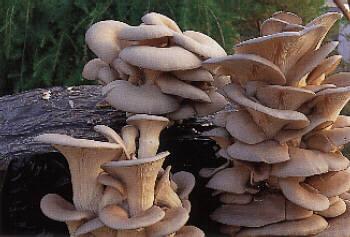Veshenka (Pleurotus) mushroom

Veshenka is cultivated in Russia since the far past, but it has become very popular only in our days. Before revolution this mushroom was called as «Ishiven» and it was highly appreciated for its palatability. Even in that time people new about beneficial characteristics of Veshenka.
Veshenka contains all the material needed for human body: proteins, fats, carbohydrates, vitamins and mineral salts. It has low caloric content, but it can satisfy the famine even in small portions. By the consistence of proteins and amino acids this mushroom is close to vegetables, but it outperforms them by the consistence of fats and carbohydrates. By the consistence of vitamins Veshenka is very similar to meat — the pulp of these mushrooms contains vitamins of B group, and also C, E and D2. Because of the level of vitamin consistence Veshenka is considered to be a very valuable mushroom. Apart from this, through the use of these mushrooms for food an organism receives the enzymes promoting the fats and glycogen splitting. The pulp of Veshenka on 7-8% consists of the following mineral substances needed for human body: iron, kalium, iodine, calcium and so on. It is considered that Veshenka reduces cholesterin in the blood and the juice of this mushroom supresses the growth of coliform bacillus.
In wilderness area Veshenka usually grows on the trees. The hat of such mushroom is one-sided or orbicular and the gills adhere to the leg. It is easy to distinguish Veshenka from inedible mushrooms — it has absolutely unleathery to the touch skin
There are seven different species of Veshenka on the territory of Russia, five of them are edible. The most valuable among them is the Oyster Veshenka. You can find it in wild nature and it can also be cultivated. Veshenka cultivated by a human has almost the same characteristics as the one gathered in the forest: flavor, consistence of beneficial material, appearance and speed of growth. Oyster Veshenka has hat of dark grey color with violet, blue or brown tone and gills of light-grey color. In wild nature Veshenka fruits quite a long time, almost until first frosts. In artificial conditions it fruits all the year.
Lung Veshenka has the highest wild nature occurrence. It is very close to Oyster one by flavor and appearance, but it has less fleshy pulp and rather short leg. Lung Veshenka fruits during not so long period — in the mid-latitudes of Russia it gives harvest from June until middle of September.
The next species of Veshenka is Corniculatus Veshenka. It is called so because of its light-sand or light-brown hat, similar by appearance to the shepherd's horn. The pulp of this mushroom is dense enough and has pleasant specific odor. Corniculatus Veshenka grows only on the elm, it occurs in forest-steppe zone of Russia and Ukraine, and also in the Northern Caucasus where it is called «Karaganchik»
One of the most favorable mushroom of Primorye Territory citizens — is Lemon Veshenka, it is distinguished by large amount of fruit bodies on the joint. Mushroom get it name because of its bright-yellow hat color.
Steppe Veshenka differs from other species by growing not on the trees, but on the rhizosphere of umbrella-type grasses. It occurs mostly in steppes of Central Asia, foothills of Tien Shan and Pamir. Steppe Veshenka is quite a valuable mushroom with dense and fragrant white pulp.
As we have already said above, Veshenka can be cultivated in artificial conditions. To do this you need a premise with 20-25 C temperature, high humidity and low light exposure. When Veshenka starts fruit you have to reduce the temperature in the premise to 15-18 C. Preparation of mycelium does not require expensive material — Veshenka will perfectly grow on deciduous tree logs, on the saw dust or on the straw.
For food Veshenka is used in fried, boiled or stewed form, and in addition, these mushrooms are available for brining. In West and South European cuisine Veshenka was added to the main dish for special aroma giving. If you dry and grate these mushrooms, you will receive seasoning of pleasant sweetish odor. It is very important to remember while Veshenka cooking, that its taste is compatible with meat and game in the best way, but it is not good for fish dishes, however like all other mushrooms.
The only condition you should follow while cooking — it is an obligatory heat treatment. Veshenka contains chitine which can not be digested by human organism. To remove it out you should cut the mushrooms into little pieces and cook them at high temperature. The taste of cooked mushrooms is something between Russule and Boletus mushroom, its smell is close to rye bread.
6930 view.